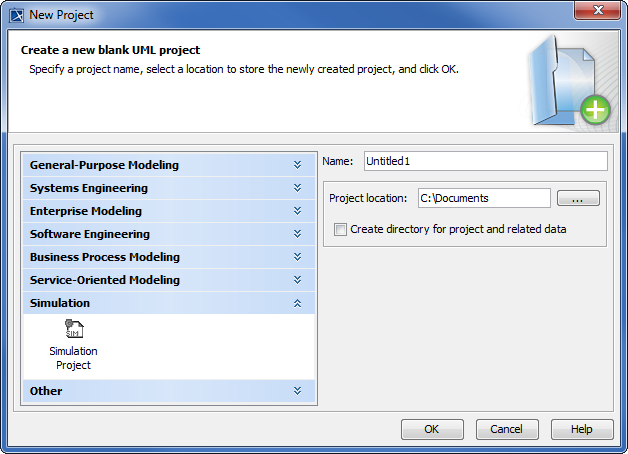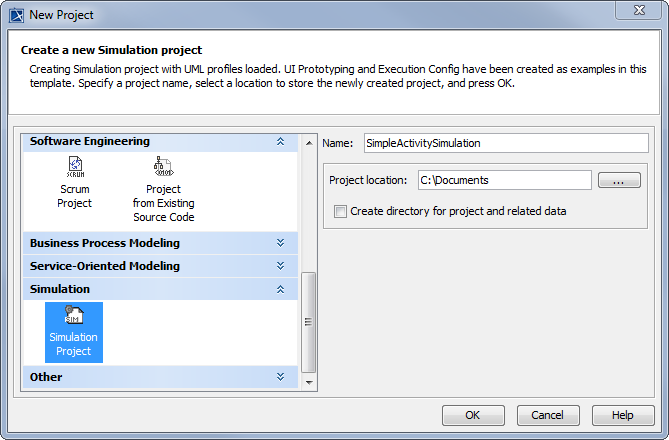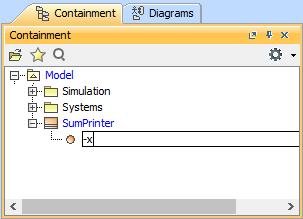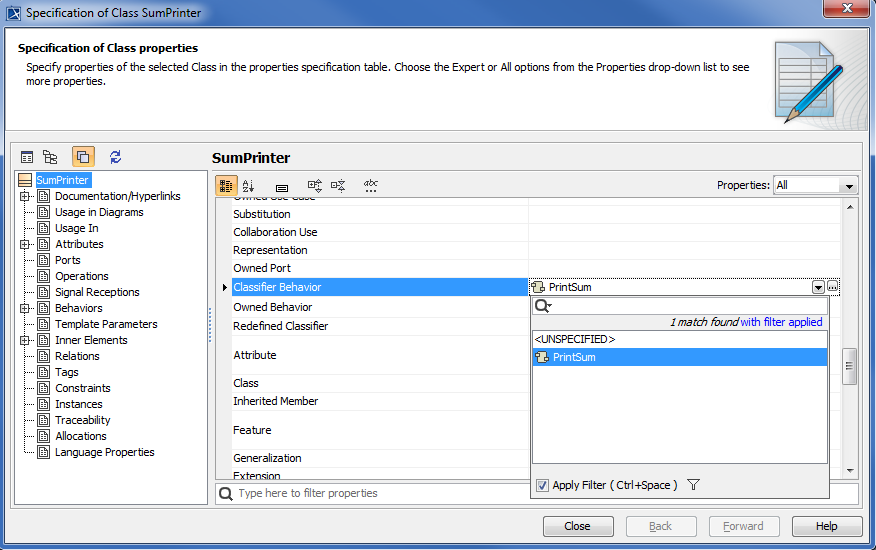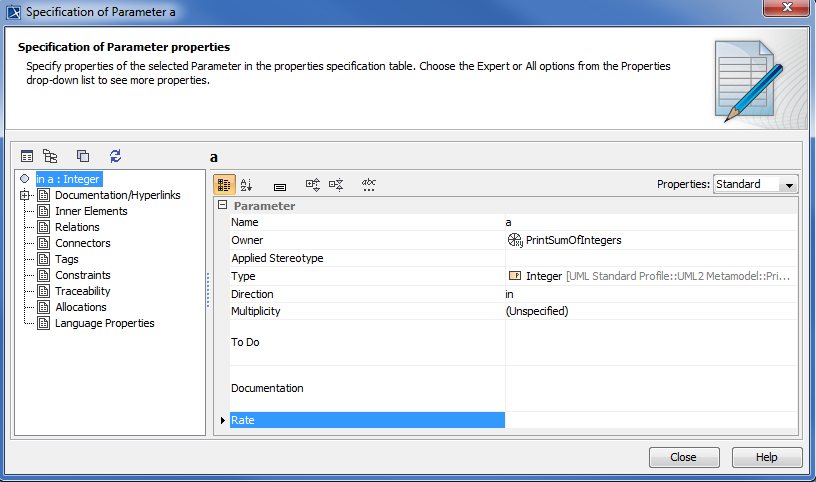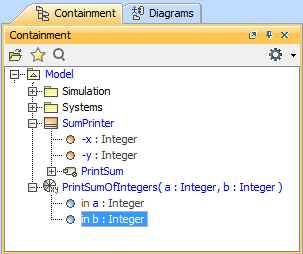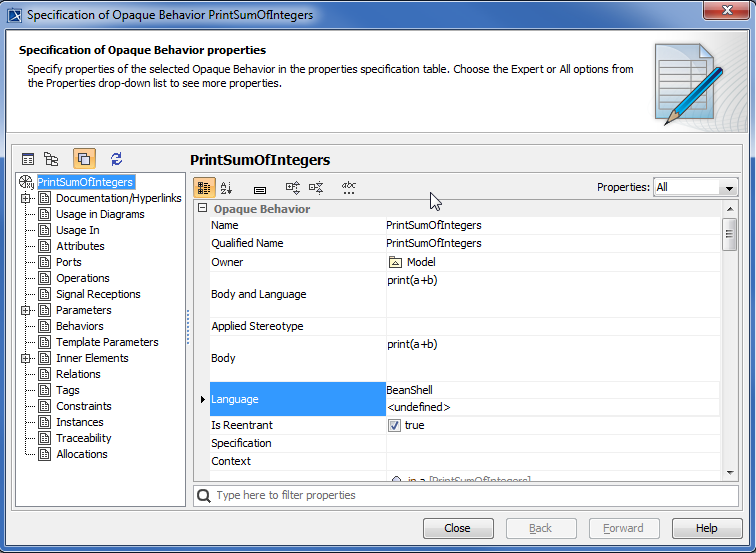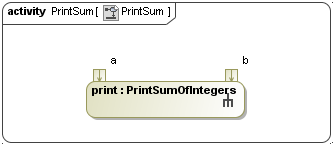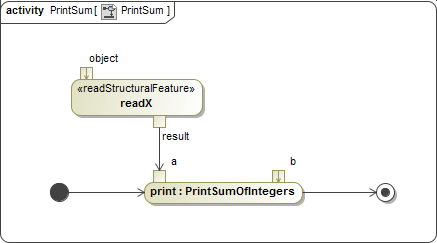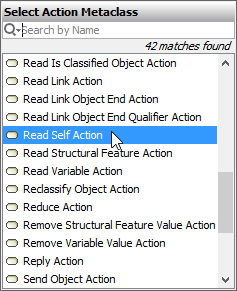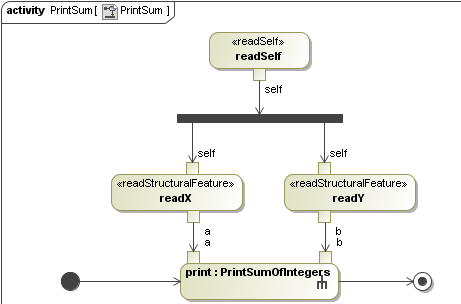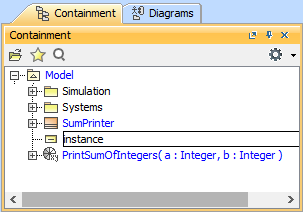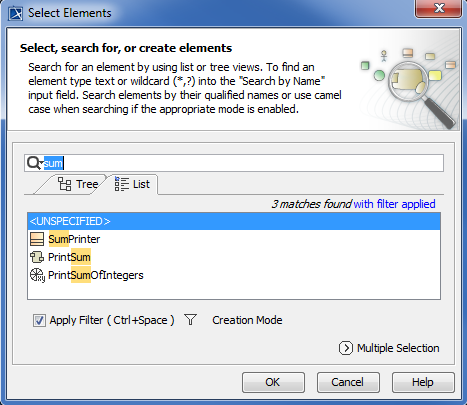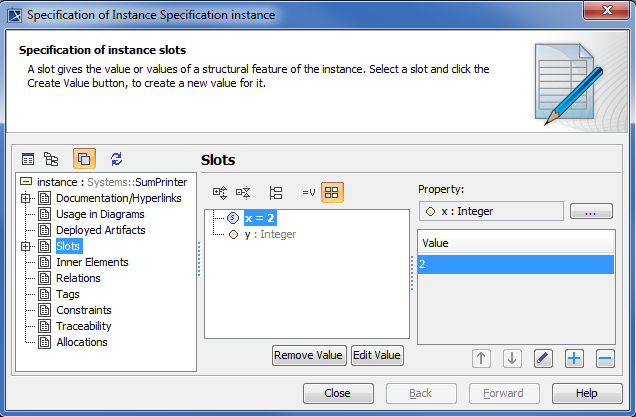You can simulate a UML Activity or a Classifier whose Classifier Behavior is defined by an Activity. This section demonstrates how to create a simple but executable Activity model through the following steps
- Create a Class containing two properties typed by Integers.
- Create an Activity to print the summation value of the two properties.
- Assign the Activity as the Classifier Behavior of the created Class.
- Create an opaque Behavior to print the summation value of two input parameters of type Integer.
- Write a script to print the summation of the given integer values that are referred to by the two input parameters.
- Complete the Activity diagram of the Class.
- Create a ReadSelfAction to read a runtime object that will be supplied to the input pins of both the readX and readY Actions.
- Create an InstanceSpecification and assign the values to the slots that correspond to the two created properties.
To create a Class containing two attributes typed by Integers
To create a new UML project, click File > New Project on the main menu. The New Project dialog will open.
Select SimulationProject from the Simulation group and specify the project's name, e.g., "SimpleActivitySimulation".
Specify the location where you want to save your project file, and then click OK.
Right-click the Model model in the containment browser and select Create Element > Class. A new Class element, which is the context of the Activity, will be created in the containment browser. Name the created Class, e.g., "SumPrinter".
Add two properties: x and y of type Integer.
Right-click the SumPrinter Class and select Create Element > Property. Type 'x' to name the property (see the first figure below). Right-click x and select Specification to open its Specification window. Select Integer as the property type (see the second figure below).
Creating a new Property x for the SumPrinter Class.
The Specification of Property x.The SumPrinter Class with the Properties X and Y of Integer Type.
Repeat Step 5 to create Property y.
Once the Properties x and y have been created, define the Behavior of the created Class: Specify the Classifier Behavior of the SumPrinter Class with a UML Activity element.
To create an Activity to print the summation value of the two properties
- Right-click the SumPrinter Class in the containment browser and select New Diagram > Activity Diagram to create a new Activity under it.
- Name the diagram "PrintSum".
Now that the Activity has been created, you need to assign it as the Classifier Behavior of SumPrinter.
To assign the Activity as the Classifier Behavior of the created Class
Right-click the SumPrinter Class in the containment browser and select Specification to open its Specification window.
- Select All from the Properties drop-down menu to make sure that all of the properties are listed in the dialog.
- Click Classifier Behavior and select the PrintSum Activity from the drop-down list on the right-hand side.
To create an opaque Behavior to print the summation value of the two input parameters of type Integer:
- Right-click the Model model in the Containment tree and select Create Element > Opaque Behavior. A new opaque Behavior will be created under the Model model.
Name it "PrintSumOfIntegers". The following figure shows the PrintSumOfIntegers Opaque Behavior in the Containment browser.
- Add two input parameters of type Integer: a and b.
Right-click the PrintSumOfIntegers opaque Behavior and select Create Element > Parameter. Name the created parameter 'a' in the name field and select Integer as the type of Parameter a (see the following figure that shows the Specification of Parameter a).
Repeat Steps 3-4 to create Parameter b as shown in the following figure that shows the PrintSumOfIntegers Opaque Behavior containing Parameters a and b in the Containment browser.
To write a script to print the summation of the given integer values
Open the Specification window of the PrintSumOfIntegers opaque Behavior and write a script in the Body field (You can use any scripting language that is supported by MagicDraw's Macro Engine, e.g., BeanShell, Groovy, JavaScript, Python, or Ruby). In this example, JavaScript will be used to print the summation of the given integer values that are referred to by the parameters a and b; therefore, the script will be: "print(a+b)".
Note
If you want to use a scripting language other than JavaScript, you can specify it in the Language attribute of the Specification window.
Specifying a Scripting Language in the Specification dialog.
The next step is to complete the PrintSum Activity diagram of the SumPrinter Class and add a ReadStructuralFeatureAction so that the values of properties x and y, which are owned by the SumPrinter Class, are readable. The values of a and b will later be passed on to the PrintSumOfIntegers opaque Behavior as the values of input parameters a and b respectively.
To complete the Activity diagram of the Class
- Drag the PrintSumOfIntegers opaque Behavior from the containment browser to the PrintSum Activity diagram. A new Action of PrintSumOfIntegers will be created.
Name the Action "print".
Add the Initial and Activity Final nodes to the Activity diagram and connect them to the print Action using a control flow. The following figure shows the Activity diagram with Initial and Final Activity nodes.
Click Action and select Any Action from the Activity Diagram toolbar on the PrintSum Activity diagram.
Select Read Structural Feature Action in the Select Action MetaClass dialog.
Click the PrintSum Activity diagram to create the Action and name it "readX" as shown in the following figure
Open the Specification window of the Action readX.
Click the Structural Feature and the button to open the Select Property dialog to select Structural Feature.
Select the Property x of the SumPrinter Class and click OK. The Select Property dialog will close.
Create an object flow from the pin result of the readX Action to pin a of the print Action. The following figure shows the Flow between readX and print Actions in the Activity diagram.
Repeat Steps 4 to 10 to create another Action named readY, which is the ReadStructuralFeatureAction, with the following arrangements
• The name of the Action is "readY".
• The structural feature is the attribute 'y' of the SumPrinter Class.
• The name of the output pin of readY is 'b'.
• The output pin b of readY connects to pin b of the print Action.
The following figure shows the Activity diagram with readX and readY Actions
To create a ReadSelfAction to read a runtime object that will be supplied to the input pins of readX and readY Actions
Click Action > Any Action on the Activity Diagram toolbar. The Select Action MetaClass dialog will open (see the following figure).
Select Read SelfAction.
Click the PrintSum Activity diagram to create an Action and name it, for example, readSelf. The following figure shows the Activity diagram with Action readSelf.
Create a Fork Horizontal and use Object Flow to connect it to the pins of the Actions readX, readY, and readSelf on the diagrams. The following figure shows a complete PrintSum Activity diagram.
The final step is to create an InstanceSpecification whose Classifier is the SumPrinter and assign the values to the slots that correspond to the properties x and y. These values will be used during the simulation.
To create an InstanceSpecification whose Classifier is the SumPrinter and assign the values to the slots that correspond to the Properties x and y
- Right-click the Model model and select Create Element > InstanceSpecification.
Name the created InstanceSpecification, e.g., instance.
Right-click the created Instance and open the Specification window of instance.
Click the Classifier field and the button. The Select Elements dialog will open.
Select the SumPrinter Class to edit the Classifier and click OK.
Click Slots on the left-hand side pane of the Specification window and select x:Integer.
Click the Create Value button to create a new value of the slot. The Value box will open for you to assign the value to Property x slot.
Type a number, e.g., 2 as the value of the property x slot.
Repeat Steps 6 to 8 to assign "8" as the value of the property y slot as shown in the following figure and click Close.
The model is now ready for you to simulate.
Related pages
